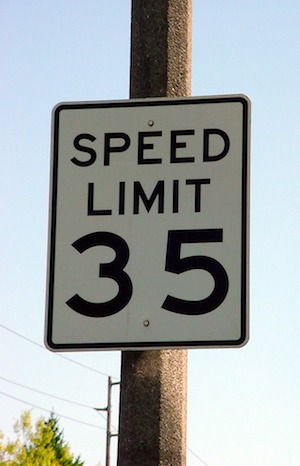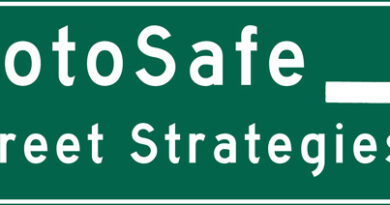Street Strategies: Speed! Limits?
Motorcyclists and speed limits seem to get along like cats and dogs. Motorcycles appear to be made for speed, lots of speed, while those ubiquitous black-on-white rectangular signs glare down at us accusingly, everywhere we ride. Speed kills, right? Well, usually it’s the sudden stop that does damage regardless of the prior speed. Is speed then NOT a factor in lower-risk riding? Sorry, yes it is; speed consumes time. Our riding lives are ruled, or so the authorities wish it so, by speed limit signs, police cruisers, radar guns and speed traps. Better it is that we motorcyclists rule ourselves than leave it to the authorities to dictate our riding behavior. We have skin in the game and authorities do not.
Rebellion and revolt with the right wrist? Actually, the opposite; responsible, skillful, independent self-determination and competent execution while aboard a motorcycle, including choice of velocity. How, then, to determine the proper speed? By proper, please accept the premise that it simply means avoiding unnecessary riding risk. Unnecessary is a key word there. Here are some principles about speed that may help.
Sight Distance vs. Total Stopping Distance: honoring your sightlines
 Accept the premise that you are traveling at highway speeds. Thus, you are covering roughly 100 feet each second. The first of the three-step motorcycle-stopping process is called Perception Distance, the number of feet the moto and you travel while you, your brain and eyes get around to noticing the need for a stop, be it hard, soft or squishy. Recognizing a risk as soon as it become visibly present reduces the amount of forward distance wasted before recognizing disaster somewhere near; wool-gathering while aboard your motorcycle wastes the precious empty pavement your time-and-space safety bubble.
Accept the premise that you are traveling at highway speeds. Thus, you are covering roughly 100 feet each second. The first of the three-step motorcycle-stopping process is called Perception Distance, the number of feet the moto and you travel while you, your brain and eyes get around to noticing the need for a stop, be it hard, soft or squishy. Recognizing a risk as soon as it become visibly present reduces the amount of forward distance wasted before recognizing disaster somewhere near; wool-gathering while aboard your motorcycle wastes the precious empty pavement your time-and-space safety bubble.
Forward travel continues during step two, Reaction Distance, which is the pavement traversed while the hands and feet get moving, pull the slack out of the braking systems and feel the braking resistance in the controls. Young folks can do this is as little as half a second, or 50 feet at highway speeds. Older riders take three to four times that in both time and distance.
Step three is Braking Distance, the distance moved forward while brakes bring the motorcycle to a full stop. This value is often shown in magazine road tests, and normally is performed by a skilled rider who is prepared to begin stopping as hard as possible at a predetermined spot on the tarmac, not under the conditions often encountered by motorcyclists. A stopping distance of 120 feet from 60 MPH equates to 1.0 G, a gold standard for braking. Most experienced motorcyclists will not achieve this high G-force, although purposeful practice can get many of us pretty close.
The mantra honor your sightlines helps us remember to estimate our Total Braking Distance, all three steps, at our present speed and compare it to current sight distances, whether ahead, oblique or to the sides, looking for the shortest one and adjusting speed to thus be able, if needed, to effect a smooth, precise, albeit forceful stop.
Motorcyclists look for blind spots and truncated sightlines in both congested and open areas, places that can hide anything big enough, if it begins moving, to hurt you; that’s just about anything bigger than a chipmunk. Imagine the worst and predict roaring disaster everywhere. You will mostly be wrong, but happy occasionally. Learn to estimate YOUR stopping distances from highway speeds, city speeds and neighborhood speeds.
Flow of Traffic
Traffic engineers discovered long ago that traffic conflicts were minimized when highway users were all traveling in the same direction at pretty much the same speed. Motorcyclists often do not survive traffic conflicts, while auto and truck users not only survive, but are very frequently unhurt. Since your personal life and health, as well as your property, are more important to you than slavishly obeying speed limits, riding with the flow of traffic regardless of the posted speed limit might be a wise principle. A motorcyclist may be called upon to explain the rationale to a law enforcement officer who may or may not accept it, but either way, the motorcyclist dealt away unnecessary riding risk at the time. Standing on principle may cost us, but it’s cheaper than skin, bones and blood.
Time-and-Space Safety Bubble
Motorcyclists who mitigate and eliminate unnecessary riding risk usually maintain a zone of nothing around the motorcycle both while riding and at rest in traffic. How large a safety bubble, how much space kept in inventory, space we can trade for time, that leisurely period needed to recognize a hazard, come up with the plan, get to feeling good about it, get the body moving and then control the motorcycle softly and precisely, is a function of each rider’s judgment, experience and motivation to reduce risk. Motorcyclists both move the motorcycle sideways while riding, moving within the travel lane, changing into another lane after signaling, as well as changing speeds, down and up, to maintain that precious bubble. In a conflict between a speed needed to maintain or improve a safety bubble and the actual speed limit, motorcyclists have to make a choice. Choose wisely.
Time at Risk
Risk has two components: degree of risk and time at risk. A particular risk might appear to have a low likelihood of springing the collision trap, relatively speaking, but the longer time passes while the motorcyclist remains in the conflict zone, the greater the likelihood that the risk, the collision trap will spring. For example, staying in the blind spot of an auto or truck for an unnecessary period of time increases the risk that a driver will, sooner or later, make a sudden swerve. Some more speed may be needed to solve the problem, reduce the time at risk and move to your best place on the roadway at that moment. As we see next, moving forward often is better than moving back. Traffic conditions and principles above may keep the motorcyclist traveling at higher speeds than the law allows.
Outrun Risks
By traveling about two to five percent faster than the flow of traffic, in an appropriate travel lane, more traffic events and traffic conflicts are kept ahead of the motorcyclists in a clear, wide view, while conflicts occurring in the after arc, where it’s so miserably hard for us to see, evaporate. Again, this principle may be at odds with the posted limit. Use good judgment.
Escape Routes
Part of maintaining safety bubble space is keeping a running tally, a changing inventory if you will, of safer places to go on those infrequent but satisfying occasions when your predicted awful disaster does actually show up. You can be prepared and have a nice place to go hide, either on the pavement or somewhere else. Your throttle and speed may be needed to get there.
As a principle begets a strategy, which then produces tactics, so do skilled and experienced muscles softly and accurately control the motorcycle as unnecessary risk disappears in your past. The motorcyclist is alone at the controls and bears the burden of enjoying a low-risk ride. These principles, offered by the BMW MOA Foundation for your consideration, may help you continually mitigate and eliminate unnecessary riding risk. Have fun, ride safe, ride often – and think!
About the author
Roger Wiles is a retired MSF RiderCoach and former BMW MOA Rider Education Coordinator. Wiles continues to maintain certification for the SMARTrainer, a motorcycle-based traffic simulation device. He has ridden for many years and miles, and lives with his wife in north Georgia.




